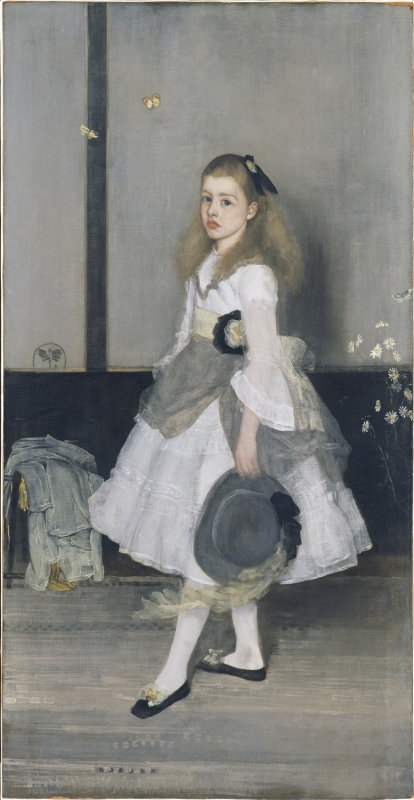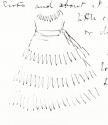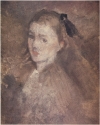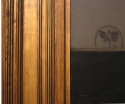Composition
As recognised by many writers and art critics, Whistler was profoundly influenced by Diego Rodriguez de Silva y Velázquez (1599-1660), and owned a photograph of a detail of the famous Las Meninas in the Museo Nacional del Prado, showing the figure of the little infanta, which is often compared to the figure of Cicely Alexander. 1
There is one oil study as well as numerous drawings related to the composition. A pastel, Miss Alexander [M.0504], signed with a butterfly, shows a similar dress, with four rows of frills on the skirt, frills at the neck, on the bodice, and at the top and bottom of the long, fitted sleeves. In this drawing the figure is facing right, not left as in Harmony in Grey and Green: Miss Cicely Alexander [YMSM 129], and her right arm crosses the body.
Whistler's mother acted as chaperone during sittings, and helped as needed. She wrote to the sitter's mother, passing on Whistler's instructions for the dress:
'his fancy is for a rather clearer muslin than the pattern enclosed in your note. I think Swiss Book muslin will be right, that the arms may be seen thro it, as in the "Little White Girl" you may remember. it should be without blue, as purely white as it can be. he likes the narrow frilling such as is upon the upper skirt of the dress Sicily [sic] has worn, & I suppose the new one can be made in the same fashion exactly.' 2
Whistler added further instructions to the letter:
'If possible it would be better to get fine Indian muslin - which is beautiful in color - It would be well to try at a sort of second hand shop called Aked's in a little street running out of Leicester Square ...
Or perhaps Farmer & Roger may have it they often keep it - But try Aked first.'
Joseph Aked was an art dealer at 16 Green Street, Leicester Square, London, WC; Messrs Farmer & Roger's Great Cloak and Shawl Emporium was at 119 Great Regent Street, where Arthur Lasenby Liberty (1843-1917) was then Oriental Manager. It was a shop specialising in hats, cloaks and woven materials.
Whistler included a sketch in the same letter, Design for a dress for Miss Cicely H. Alexander [M.0503] (reproduced above), showing three rows of frills on the skirt and one round the neck.
'The dress might have frills on the skirts and about it - and a fine little ruffle for the neck - or else lace -
Also it might be looped up from time to time with bows of pale yellow ribbon -
In case The Indian muslin is not to be had - Then the usual fine muslin of which Ladies evening dresses are made will do - the blue well taken out - and the little dress afterwards done up by the laundress with a little starch to make the frills and skirts &c stand out, & of course not an atom of blue!' 3
Finally, Anna Whistler completed the letter:
'As I handed as far as I had written, to my Son for his approval, he went on with it himself but, that you need not feel nervous about the time alotted, I have taken the freedom to put the dress left in my keeping, into the hands of my Laundress merely to extract the slight hue of sky blue, which is the sole objection, and so, it will be ready for Friday if the one ordered cannot be finished by then.' 4
Another small drawing, Study for the portrait of Miss Cicely Alexander [M.0505], shown above, is a particularly vivid pastel showing the main elements of the colour and composition, though not the girl's features.
There is an oil study of Cicely's head (Study for the Head of Miss Cicely H. Alexander [YMSM 128]), which may well represent an early stage in the evolution of the portrait.
Miss Cicely Alexander [M.0844], a pen drawing in the Baltimore Museum of Art, has most of the features of the completed composition, although the grey ribbon on the bodice and grey drapery round her waist are missing, and the black rosette on the waistband is larger. This is probably a memory sketch of the painting, and was drawn in or after 1880. 5
The finished portrait, Harmony in Grey and Green: Miss Cicely Alexander, is related to Whistler's other studies of women in white, and particularly to a painting of similar date, Harmony in Grey and Peach Colour [YMSM 131]. This showed Maud Franklin (1857-1939), and incorporates elements of the dress, colour, and design in what appears to have been planned as a slightly grown up version of the portrait, but which was left in an incomplete state.
A proposed portrait of a child in similar dress and composition, dating from the late 1880s, but which never got beyond the planning stage, is shown in another drawing, Lady Gordon's daughter [M.0994].
Technique
In November 1872 Cicely was posing twice a week. 6 The portrait required over 70 sittings before it was completed. The sitter described her sittings as follows:
'he never let me change my position. ... he used to stand a good way from his canvas, and then dart at it, and then dart back, and he often turned round to look in a looking-glass that hung over the mantlepiece at his back - I suppose to see the reflection of his painting.' 7
According to Walter Greaves (1846-1930), 'the picture was painted on an absorbent canvas, and on a distemper ground'; Greaves also said that 'my sisters made the carpet of black and white tape which Whistler used when painting this portrait.' 8
A detailed report by Professor Joyce H. Townsend adds valuable details on the technique, condition and conservation of the painting:
'Whistler’s canvas was fine, smooth and not primed, though it was sized with glue. He applied a thin imprimatura that was darker than a mid tone, made from lead white and bone black, over the background, and a similar but lighter grey, still thin, over the entire canvas. After each application of paint, Whistler rubbed down the surface. The final application of paint was not rubbed down, except in the hat and the panelling below the dado rail. The lighter colours on top extend beyond the darker tones with which he began the process each time. The brushmarks suggest he used both quarter and half inch brushes (6 mm and 12 mm wide).
The fuzziness of an X-radiograph of the figure, as well as an infrared photograph, testify to many wipings off and scrapings down of paint, over the reported seventy sittings. There is no evidence from the X-radiograph for any earlier use of the canvas, save for one puzzling brushstroke running from the hair ribbon down through the left eye. The left hand was moved in position by about its own width, by wiping paint, which makes the extent of the change difficult to quantify. The left leg was repositioned slightly. Possibly a chair was behind Cicely at an early stage, which could account for the slight change, but none of the sketches support this inference from the X-radiograph. The line of the bodice was altered slightly and not then rubbed down, concealing the earlier line. The rubbing down of unsatisfactory versions of the face was more thorough, so the paint that remains is thin. The X-radiograph shows the line of the neck beneath the hair, hence the hair was finished at a late stage.
The shadow was applied over the imprimatura that already surrounded the figure with a thin grey veil of colour. For the carpet, Whistler worked from dark to light, using very thin washes of colour. The flowers and butterflies were applied on top, in more opaque and thicker paint, which has cracked locally. Wherever the paint is not so thin that the colour beneath shines through, there are small-scale 'orange peel' drying defects on the surface, indicative of problems with the drying rate of the paint thinner. Such thinned paint presents huge technological difficulties, that Whistler would overcome in later years by skill and experience, as physically thin layers of much-thinned dark paints became his standard method for portraits.
The thicker brushstrokes, that were so pleasing to Whistler that they escaped being rubbed down, indicate that all the light-coloured paints are mixtures of the same pigments seen alone in brighter areas of feather, ruffle and butterflies. In fact, both the subtle and the crisp white areas are optical mixtures of bone black, cadmium orange/red, cadmium yellow and cobalt blue in lead white. Rose madder is present in some of the mixtures. The yellow sash, darker grey costume details, the chartreuse feather in the hat and the chartreuse of the cloak on the chair all contain the same limited palette of colours, and so do the yellow daisies behind Cicely. Whistler’s ‘universal harmoniser’ of ivory black (bone black) can be found in every layer and every area, but the brighter yellow and orange butterflies above her head have a different mixture of pigments, and likely were applied during a later stage of painting, since they break the colour harmony maintained so rigorously everywhere else. They contain strontium yellow, chrome orange, cobalt blue and zinc white added to lead white.
The optical effect of the dark grey imprimatura is to make the whole surface appear darker: the back of the chair against the wall, for example, is very difficult to see today. The effect is most noticeable in the hair, which now looks too transparent, and is more suggestive of reworking than are other areas, although this area also softened more than others during lining treatment of the canvas in 1942, and now looks smoother. The fact that the brushstroke running from the hair ribbon to the left eye is visible beneath the mid-toned hair on close inspection, but not beneath the paler flesh paint, suggests that the optical effect due to natural ageing of the paint predominates. The area for the hat, its position already determined through sketching, was reserved. That is, the hat was not painted on top of fabric fully elaborated beneath it. Thus it looks much more substantial than the chair back, and preserves the carefully-planned freshness and spontaneity of the child’s costume.' 9
Conservation History
It appears to have been varnished by the picture restorer Orazio Buggiani (b. ca 1818) in 1878, after which Whistler asked Joseph Edgar Boehm (1834-1890) to come to his studio to see his paintings:
'... the fine sketch of Carlyle, the really beautiful picture of little Miss Alexander (all just varnished and seen for the first time in their full richness of color) you will feel that truth is on my side and have renewed confidence in the painter! ...
The little girl simply lives and breathes and stands in the room with us - and as Signor Buggiani, who has passed his days with the old Masters, says, "On ne fait pas mieux que ça! - on n'a jamais fait mieux que ça!".' 10
It was cleaned by Stephen Richards (1844-1900), picture restorer, before being exhibited in 1892. Whistler sent instructions, 'I want you to be particularly careful with the Miss Alexander ... I have seen [Grau] to-day - and have told him about taking the measure for the glass for the Miss Alexander picture.' 11 Richards therefore wrote to W. C. Alexander:
'Mr. Whistler tells me that you wish me to clean and revarnish the portrait of "Miss Alexander" ... so that it may be then glazed -
Will it be convenient that I should send for the picture this week, say tomorrow or Friday, so that I should be enabled to begin the cleaning before Mr. Whistler leaves town next week as he is most anxious to superintend the process.' 12

Harmony in Grey and Green: Miss Cicely Alexander, photograph, 1892, Goupil Album, GUL Whistler PH5/2
Afterwards, Whistler told Alexander, 'Your own little White Lady will astonish you I think when you see it again - it will be so fair and lovely!' and indeed, according to the artist Sidney Starr (1857-1925), it appeared to much greater advantage than in 1883, having a 'more delicate quality, the white having gained translucence.' 13
Professor Townsend adds further information on conservation and condition, as follows:
'The painting is in its original format, evidenced by the cusping marks that indicate the original attachment of the canvas to the stretcher with tacks, though it was lined with wax/resin in 1942, under the supervision of National Gallery restorer Helmut Ruhemann. The work was carried out at Glasgow Art Gallery, since paintings had been removed from London in 1939 to avoid bomb damage during WW2.
It had previously had its original varnish removed and replaced in London by restorer Stephen Richards before its exhibition in 1892, under the supervision of Whistler, in consequence of which "the peculiar yellow and green tone which excited such enthusiasm has almost disappeared and there is no longer anything out of the common [in] the black of the shoes." It would appear that glass was first put into the frame at this time. In 1932 that varnish was "revived" by W. Holder & Sons, by "removing milkiness, rectifying patches of discoloured varnish": this does not mean that it was removed. The 1942 treatment involved trimming the edges, removing the varnish and re-varnishing, as well as lining. Since the stretcher is today not original, this must have been its date of replacement.
In 1977 surface dirt was removed from this varnish by Christopher Holden at Tate. In 1979 the yellowed varnish and retouchings associated with lining damage in 1942 were removed along with any residues of the original varnish, by Stephen Hackney at Tate. At the same time, the black overpaint of 1942 was thinned, and the surface was re-varnished with the non-yellowing synthetic acrylic resin Paraloid B-72 and in places with the similar Paraloid B-67 applied on top to reduce matteness. No doubt this removal of yellowed natural resin varnish had a similar visual effect to that noted in 1892, and enabled Whistler’s subtle colour harmony to be seen once more as he had painted it. Since that time it has not required further treatment.' 14
Frame
1874: Flat Whistler frame, oil gilt on wood (oak on pine) which was originally painted with a basket weave decoration on the frieze similar to that seen on Arrangement in Grey: Portrait of the Painter [YMSM 122]. 15
1892: the frame was cleaned and regilded by Frederick Henry Grau (1859-1892), thus removing the painted decoration.
This is an excellent example of a Whistler painting that possesses its original wooded frame but does not display the original surface. The first state of the frame would probably have had a basket-weave pattern painted on the flat, mirroring the pattern seen at young Cicely’s feet. 16
This decoration was removed from the painting’s frame during preparations for the Goupil Gallery exhibition in 1892. On 3 March, Whistler told D. C. Thomson to instruct Frederick Henry Grau (1859-1892) 'To scrape and regild frame to Miss Alexander - Never mind about painting on frame - will do that myself by & bye - Gold same soft colour as on portrait of my Mother.' 17 By this he meant, like the frame on Arrangement in Grey and Black: Portrait of the Painter's Mother [YMSM 101].
Whistler also reassured Mrs Alexander, 'Grau has had orders to thoroughly clean and regild the frame - and after wards, if you wish it, I will with great pleasure repaint the ornament upon it.' 18 As evidenced by the current surface frame, it appears that the ‘by & bye’ never occurred and Whistler did not replace the painted decoration. Whistler often significantly altered the surface, or entirely changed his frames. Sometimes such changes were made twenty years after the initial creation date.
Notes:
1: D. Velázquez, Las Meninas, photograph of detail owned by Whistler, GUL Whistler PH3/8. On the influence of Velázquez, see for instance Pennell 1908 [more] , vol. 1, pp. 172-73.
2: A. M. Whistler to R. A. Alexander, 26 August [1872], GUW #07571; Design for a dress for Miss Cicely H. Alexander [M.0503].
3: Ibid.
4: Ibid.
5: A memory sketch, drawn by Whistler to show the composition to Rosa Frances Corder (1853-1893), was acquired by Charles Augustus Howell (1840?-1890) and has disappeared; note by C. A. Howell, GUL Whistler LB11/12.
6: A. M. Whistler to J. H. Gamble, 5 and 22 November 1872, GUW #06553.
7: Pennell 1908 [more] , vol. 1, pp. 173-74.
8: Pennell 1908, op. cit., vol. 1, p. 175; Marchant 1911 [more] , p. 10.
9: Prof. J. H. Townsend, Tate Britain, report, 2017; Townsend, J. H., 'Whistler's oil painting materials', The Burlington Magazine, 1994, vol. 136, pp. 690-95. Hackney, Stephen (ed.), Completing the Picture: Materials and Techniques of Twenty-six Paintings in the Tate Gallery, Tate, London, 1982, pp. 61-64.
10: 20 November [1878], GUW #00322.
11: Whistler to S. Richard, [6 January 1892], GUW #10884.
12: 6 January 1892, GUW #07577.
13: Whistler to W. C. Alexander, [14 February 1892], GUW #07575; Starr 1908 [more] , pp. 532-33; see also Whistler to D. C. Thomson, [20 February 1892], mentioning its 'splendid condition', GUW #08219.
14: Townsend 2017, op. cit.
15: Dr Sarah L. Parkerson Day, Report on frames, 2017; see also Parkerson 2007 [more] .
16: Ibid.
Last updated: 5th June 2021 by Margaret
















